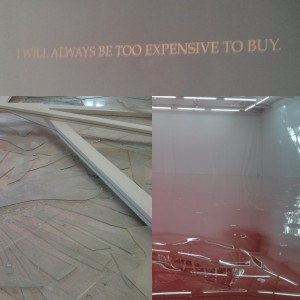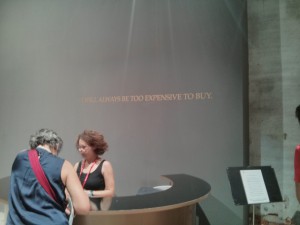 After “Three artistic approaches to conditions of labour” and “Artistic views on the world order” we are glancing at three female participations to the 56th International Art Exhibition in Venice. The first view in on “The Probable Trust Registry”. It is the awarded work from Adrian Piper in the Arsenale. Then we move to the Giardini and the national Pavilions with Camille Norment’s “Rapture” in the Nordic Pavilion and the participation of Switzerland “Our Product” by Pamela Rosenkranz.
After “Three artistic approaches to conditions of labour” and “Artistic views on the world order” we are glancing at three female participations to the 56th International Art Exhibition in Venice. The first view in on “The Probable Trust Registry”. It is the awarded work from Adrian Piper in the Arsenale. Then we move to the Giardini and the national Pavilions with Camille Norment’s “Rapture” in the Nordic Pavilion and the participation of Switzerland “Our Product” by Pamela Rosenkranz.
Adrian Piper: “The Probable Trust Registry: The Rules of the Game
– I will always be too expensive to buy”
For her solo exhibition “The Probable Trust Registry” at the Elizabeth Dee Gallery Gallery in New York 2014, AdrianPiper created an installation-group performance which invited the visitors to participate. For the Biennale Okwui Enwezor had chosen only a part of this installation. It is a reception area with a friendly receptionist. The significant sentence “I will always be too expensive to buy” is written in golden letters at the wall behind the lady. On the first view this seems to work well with the reading of “Das Kapital” as heart of the exhibition, especially with a nice lady sitting at the reception area under these golden letters. A closer look, however, reveals that it is not regarding whether the lady is on sale or not. The installation is about a personal promise from the participants never to be corruptible.
To do so the volunteer signs his personal declaration in duplicate and a mailing address book, which is confidential. The signatory retains one copy of his declaration, the other one becomes part of the Adrian Piper Research Archive Foundation Berlin confidential inventory after the end of the exhibition. Here it is sealed to the public for 100 years.
After the end of the exhibition its organiser will send copies of all contracts to each signatory, but only to them. Except with explicit permission of the signatory, no more information, like contact details, are accessible to third. In case a signatory wishes to contact a cosignatory, he/she needs to contact the organiser of the exhibition, who will only submit the information with the authorisation of the cosignatory. This guarantees the personal privacy of each participant.
In consequence the control about keeping the promise is reserved to each signatory personally. Each signatory decides for his own whether to be corruptible or not in the future. For one it might be only a game; for another a question of self-conception; for some it could help to have a indirect agreement with Adrian Piper and some signatories might wish to find like-minded to strengthen their conscious. In any case when the signatory takes his/her promise not to be buyable serious the contract will affect his/her live sustainable. Hopefully the artist contributed to a little less corruptible society.
The Jury of the 56th International Art Exhibition of la Biennale di Venezia awarded Arian Piper with the Golden Lion for the Best Artist.
Although the contribution of Camille Norment as national participation of Norway in the Nordic Pavilion in the Giardini is as well an installation accompanied by performances, its nature is totally distinct from Adrian Pipers work. Obviously this is due to the individual artistic approach, but certainly also to the different point of depart. While Piper developed her “The Probable Trust Registry” as a conceptual artwork, Norment had mission to create something site-specific for the Nordic Pavilion.
Camille Norment: “Rapture”
Seeing the Nordic Pavilion is like looking at a battle field. The huge glass windows of the building are out of their frames, some are lying on the ground, panes are broken, everywhere are fragments of broken glass. In view to the title “Rapture” someone seems to have let his/her aggressions run free. Nevertheless, as in Pipers installation it is not like it looks at first glance.
Perhaps inspired by the transparent outer walls of the pavilion Camille Norment refers her work to the glass armonica. This is an instrument, invented by Benjamin Franklin in 1761. It is built out of 37 glass bowls mounted on an iron spindle. Via a foot pedal this spindle is turned around. The musician playing the instrument touches the bowls with wet fingers so it makes sound, which was described by Franklin as “angelic”. In its high time it was played inter alia by Mozart and Marie Antoinette. Later it came out of fashion, if not banned. Other, less fragile harmonicas were invented. Besides its sound was attributed to undesirable properties: “The glass armonica’s stimulation was deemed excessively sexual for women, and the power to heal deemed boarderline to creating illness or even causing death.” So the glass armonica stands for the two extremes of the same medal: the relaxing, perhaps healing function of its music and the devastating.
Here we are at the link to the antagonism that marks the installation. It is not only the deconstructed outer skin of the building that creates the work from Camille Norment, but as well a sound installation. In the back part of the pavilion there are 12 loudspeakers in form of boom microphones hanging from the ceiling. They fill the space with a chorus of female voices singing a triton which is called as well diabolic. Nevertheless, it’s a spherical music, which creates – in harmony with the gently through the glass fragments blowing wind – an atmosphere of meditation: a quiescent pole, beyond the hurly-burly of the art business. In addition to the sound installation there were several performances by the Camille Norment Trio and others where the glass armonica was played with special new composed music.
The whole installation is ambiguous: we have the calm meditative impression which contrasts to the act of destruction of the protective membrane of the building. Both, the meditation and the aggression might lead to a state of ecstasy, the removal of boundaries, inner or outer. It’s a condition of rapture.
With “Our Product” in the Pavilion of Switzerland, Pamela Rosenkranz offered us once again a site-specific installation. Even if her approach is in parts historical like in “Rapture”, it is evidently another form of artistic abstraction. Both installations have a formal aspect in common: the blurring in between interior and exterior.
Pamela Rosenkranz: “Our Product”
Entering the precinct of the Swiss Pavilion one recognizes a light green colour coming from the courtyard. Turning left the source gets visible: on the top of the outer wall are several spotlights installed. They are bathing the space in verdant light. The colour is not a natural one, but one which is often used to highlight trees and bushes in public spaces. On the opposite white wall of the loggia the effect manifests the greatest impact. From here one enters a narrow corridor which reflects the tint once more. Finally at the end of the passage the view opens into the main interior space of the pavilion. But the way inside is blocked by a half high wall, so that one can only get a view by a square opening.
The room is filled with a rose liquid, which is blubbering. Its colour is reflected on the white walls, like the green light outside. There are only cold neon lights at the ceiling, mirrored on the liquid surface. In addition there is the synthetic sound of water, generated by an algorithm in real time and the scent of fresh baby skin.
All in all it is first a confusing situation: seen as colour installation it is not a genuine complementary contrast; that would have been green in opposition to red, not to rose. In the sense of van Gogh’s colour theory, it can be seen perhaps as terrible contrast, because it’s not a real one.
Otherwise, there is a contrast in between the outer space, which might stand for nature and the inner space, which give an artificial impression. Nevertheless, the green light is coming from the “real” outside, entering the loggia as interspace and finds its way through the corridor. With it are coming the smells and sounds from the outside and dissolve the separation of interior and exterior.
To interpret the basin of rose liquid and its associated elements we need to know more. The rose is the colour of the northern European skin-tone. For Rosenkranz it refers to the “carnate”, the colour used in the Renaissance to depict human flesh and to the colour used in contemporary advertising to illustrate the qualities of human healthy. In cooperation with Dominique Ropion and Frederic Malle she created a scent which mirrors this European skin-tone.
Pointing to the Renaissance Rosenkranz hints to the liberation of religion and a scientific approach to the human being. At the same time the Renaissance stands for the measuring of the world to bring it into a universally valid pattern, like Leonardo and others had done with schematic drawing of the perfect proportions of the human body. With different intentions the current advertising industry tries to create an image of the perfect human being.
“Our Product” shows the impact of constructed human being in contrast to nature, even if this nature is as well created by humans. Nevertheless, the artificial production of life symbolizing elements like colour, scent and sound joining nature is confusing. Are these our genuine feelings, our sensitivities or hormones which we are meeting or is it only that we are lead to believe what is life?











